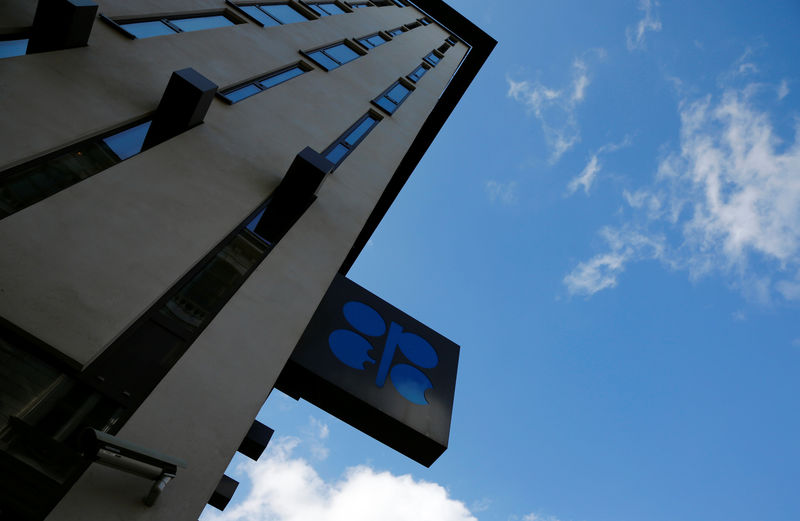(Bloomberg) -- OPEC and its allies look set to stick with their current strategy when they meet next week, renewing a deal to restrain oil supplies to prop up prices. But in a market clouded by uncertainties, they’ll probably also hint at how the policy may change.
As oil demand falters amid a global economic slowdown and supplies swell thanks to the U.S. shale boom, the coalition spearheaded by Saudi Arabia and Russia is expected to formally prolong output curbs for another six months.
However, with the market being increasingly pulled in different directions by the drawn out U.S.-China trade dispute and a potential military flare-up in the Persian Gulf, the group that pumps about half the world’s oil is likely to keep its options open.
“We’re gyrating between two stories -- a trade war and a shooting war,” said Helima Croft, chief commodities strategist at RBC Capital Markets in New York. “The Saudis are likely to signal that they’re ready to swing production either way, and be nimble. More like a speed-boat than a battleship.”
The 24-nation alliance between the Organization of Petroleum Exporting Countries and its partners, known as OPEC+, will gather in Vienna on July 1-2 to decide its next move. Saudi Arabian Energy Minister Khalid Al-Falih said on June 7 that an agreement to extend the cuts is “almost in the bag.” Russia, the other heavyweight in the alliance, prefers to wait until the leaders of the two nations meet at this week’s Group of 20 summit in Japan before deciding.
The case for prolonging the accord -- which calls for curbing production by 1.2 million barrels a day and ends this month -- is straightforward. Oil demand growth is being eroded by the weakest global economic expansion in a decade and the U.S.-China tariff feud. At the same time, supplies from outside OPEC are surging, with American production hitting record highs.
The resulting abundance of crude is keeping prices near $65 a barrel in London, below the levels needed by most OPEC nations to cover government spending. Saudi Arabia, the cartel’s biggest member, requires a price of $85 to balance its budget, according to the International Monetary Fund.
“The one tie that binds these countries, and Russia as well, is the need for higher revenue,” said Croft. “They may not like each other, but they all have a similar incentive right now.”
What of Production?
Nonetheless, even if OPEC+ formally agrees to preserve its supply curbs to the end of 2019, it doesn’t mean the group’s production will remain steady. When they hold a closing press conference on July 2, Saudi Arabia and Russia could address the different possibilities.
The market faces a range of supply crises, most notably in OPEC member Iran, that may compel other producers in the cartel to boost output. The nation’s production has been squeezed to the lowest since the 1980s by American sanctions, and may decline further as the measures take full effect.
Tensions in Middle East have also increased as Saudi oil tankers and pipelines have been attacked, and Iran shot down a U.S. Navy drone, raising fears of a wider supply disruption.
The Saudis have promised to cover for the losses from Iran, their political foe. U.S. President Donald Trump, who has urged the kingdom to ramp up production and bring down oil prices, could apply more pressure to open the taps.
Saudi Arabia has also cut production more than pledged, giving it room to increase output without violating the agreement. The kingdom may signal that intent next week, according to BNP Paribas (PA:BNPP) SA’s Harry Tchilinguirian. An OPEC estimate shows that global inventories will contract sharply in the second half if the pact is extended, giving the group scope to increase supply.
“Given that OPEC+ is currently over-delivering on output commitments, this can allow for collective production to rise,” said Tchilinguirian, BNP’s head of commodity markets strategy. “The expected decision to roll over the supply cuts will probably be accompanied by an explicit aim” to bring the cuts back in line with the original target, he said.
Alternative Scenario
Other analysts see an alternative scenario. The U.S. shale boom and threat of a global recession could lead to a oil-supply glut, potentially driving OPEC to signal that it’s ready to deepen supply curbs.
“Barring a large additional geopolitical disruption, producers face a supply tsunami even before factoring in a growth slowdown,” said Bob McNally, president of Rapidan Energy Advisors LLC and a former oil official at the White House under President George W. Bush. “I wouldn’t be surprised if there was verbal commentary about possibly deepening cuts, if needed.”
The situation in the global market is so volatile, that even the next few days before OPEC+ ministers gather in Vienna could contain an oil-demand surprise. Consumption could recover if Trump and his Chinese counterpart Xi Jinping make progress in resolving their prolonged trade dispute when they meet at the G-20 later this week.
Iraq’s Oil Minister Thamir Ghadhban hinted at this possibility, saying at the CWC Iraq Petroleum Conference in London on Thursday that his country is committed to the OPEC+ deal, but ready to satisfy demand growth when the oversupply disappears. He said he hoped the group would agree to extend the cuts at least at current levels.
Whichever course OPEC+ takes on supply, there are dangers. By increasing production in the second half, it risks a repeat of the price crash at the end of last year. By cutting further, the group may boost prices and end up encouraging more investment in U.S. shale and a create a fresh surplus.
“They’re in a bit of a rock and a hard place,” Amrita Sen, chief oil analyst at consultants Energy Aspects Ltd., said in a Bloomberg television interview.
(Updates with comment from Iraq Oil Minister in 18th paragraph)
